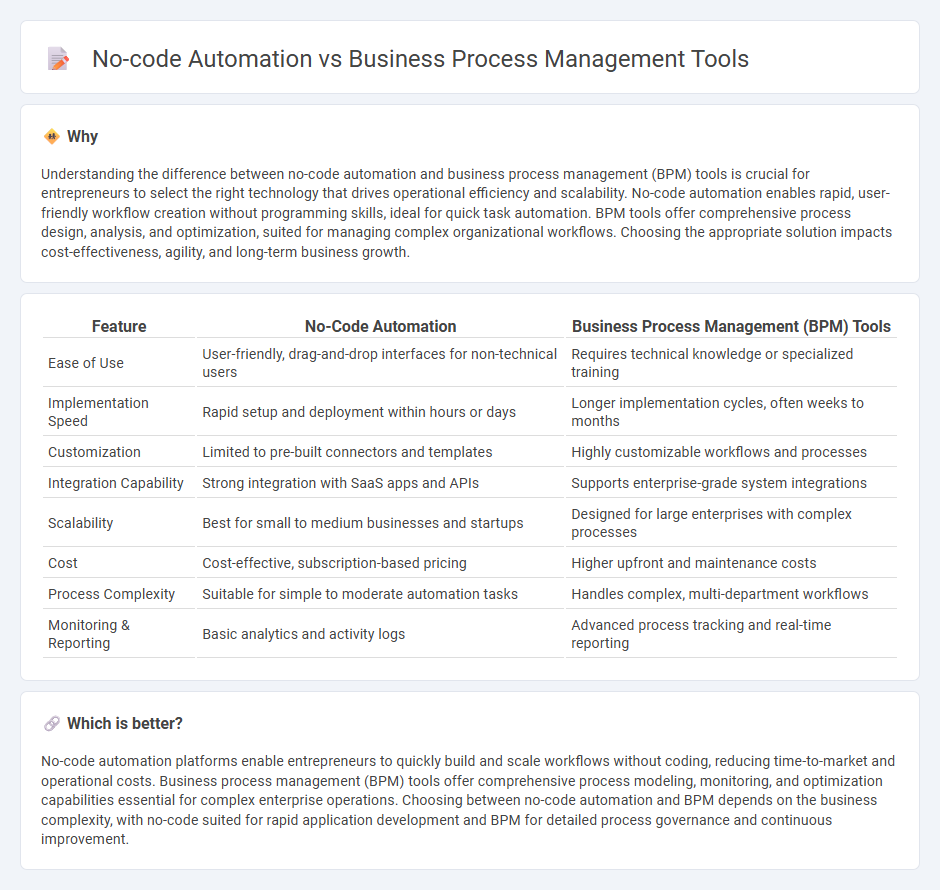
No-code automation platforms empower entrepreneurs to design and implement workflows without coding expertise, accelerating business operations and reducing dependency on IT teams. Business process management (BPM) tools offer comprehensive frameworks to analyze, optimize, and monitor complex business processes, ensuring efficiency and scalability. Explore the key differences and advantages of no-code automation versus BPM tools to enhance your entrepreneurial journey.
Why it is important
Understanding the difference between no-code automation and business process management (BPM) tools is crucial for entrepreneurs to select the right technology that drives operational efficiency and scalability. No-code automation enables rapid, user-friendly workflow creation without programming skills, ideal for quick task automation. BPM tools offer comprehensive process design, analysis, and optimization, suited for managing complex organizational workflows. Choosing the appropriate solution impacts cost-effectiveness, agility, and long-term business growth.
Comparison Table
| Feature | No-Code Automation | Business Process Management (BPM) Tools |
|---|---|---|
| Ease of Use | User-friendly, drag-and-drop interfaces for non-technical users | Requires technical knowledge or specialized training |
| Implementation Speed | Rapid setup and deployment within hours or days | Longer implementation cycles, often weeks to months |
| Customization | Limited to pre-built connectors and templates | Highly customizable workflows and processes |
| Integration Capability | Strong integration with SaaS apps and APIs | Supports enterprise-grade system integrations |
| Scalability | Best for small to medium businesses and startups | Designed for large enterprises with complex processes |
| Cost | Cost-effective, subscription-based pricing | Higher upfront and maintenance costs |
| Process Complexity | Suitable for simple to moderate automation tasks | Handles complex, multi-department workflows |
| Monitoring & Reporting | Basic analytics and activity logs | Advanced process tracking and real-time reporting |
Which is better?
No-code automation platforms enable entrepreneurs to quickly build and scale workflows without coding, reducing time-to-market and operational costs. Business process management (BPM) tools offer comprehensive process modeling, monitoring, and optimization capabilities essential for complex enterprise operations. Choosing between no-code automation and BPM depends on the business complexity, with no-code suited for rapid application development and BPM for detailed process governance and continuous improvement.
Connection
No-code automation platforms streamline entrepreneurship by enabling business owners to design and implement workflows without coding expertise, accelerating project execution and reducing time-to-market. Business process management (BPM) tools complement this by providing structured frameworks to analyze, optimize, and monitor these automated processes, ensuring scalability and operational efficiency. The integration of no-code automation with BPM empowers entrepreneurs to rapidly adapt to market changes while maintaining control over complex business operations.
Key Terms
Workflow Automation
Business process management (BPM) tools offer comprehensive solutions for modeling, analyzing, and optimizing workflows across complex organizational processes, while no-code automation platforms enable users to create and deploy automated workflows without programming skills, focusing on ease of use and rapid implementation. Workflow automation through BPM tools often involves detailed process mapping and integration with enterprise systems, whereas no-code automation emphasizes drag-and-drop interfaces and pre-built connectors for quick task automation. Explore the advantages and best-fit use cases of both approaches to determine the ideal workflow automation strategy for your business.
Integration
Business process management (BPM) tools offer robust integration capabilities with enterprise systems, enabling seamless data flow across CRM, ERP, and legacy applications through APIs and prebuilt connectors. No-code automation platforms excel in rapid integration with cloud services and SaaS applications via visual interfaces and drag-and-drop connectors, catering to users without coding expertise. Explore how these integration approaches impact scalability and efficiency for your organization's digital transformation.
Customization
Business process management (BPM) tools offer extensive customization through configurable workflows, detailed process mapping, and integration capabilities tailored to complex organizational needs. No-code automation platforms prioritize user-friendly interfaces and pre-built templates, enabling rapid customization but with limitations in deeply intricate process adjustments. Explore how each approach can enhance your organization's efficiency by learning more about their customization potential.
Source and External Links
Top 16 Business Process Management Tools - This guide lists and reviews the top BPM tools of 2025, highlighting solutions like Zluri, Pipefy, IBM Business Process Manager, and Appian BPM Suite for workflow automation, process monitoring, and operational efficiency.
9 Open Source BPM Tools to Streamline Your Business - Profiles leading open-source BPM tools such as ProcessMaker, Bizagi Modeler, and jBPM, emphasizing their low-code capabilities, cross-platform support, and collaborative features for process modeling and automation.
BPM software for business process management | SAP Signavio - Showcases SAP Signavio Process Transformation Suite, a cloud-based BPM solution that integrates process mining, modeling, analysis, and optimization tools for rapid, data-driven business process improvement.
 dowidth.com
dowidth.com